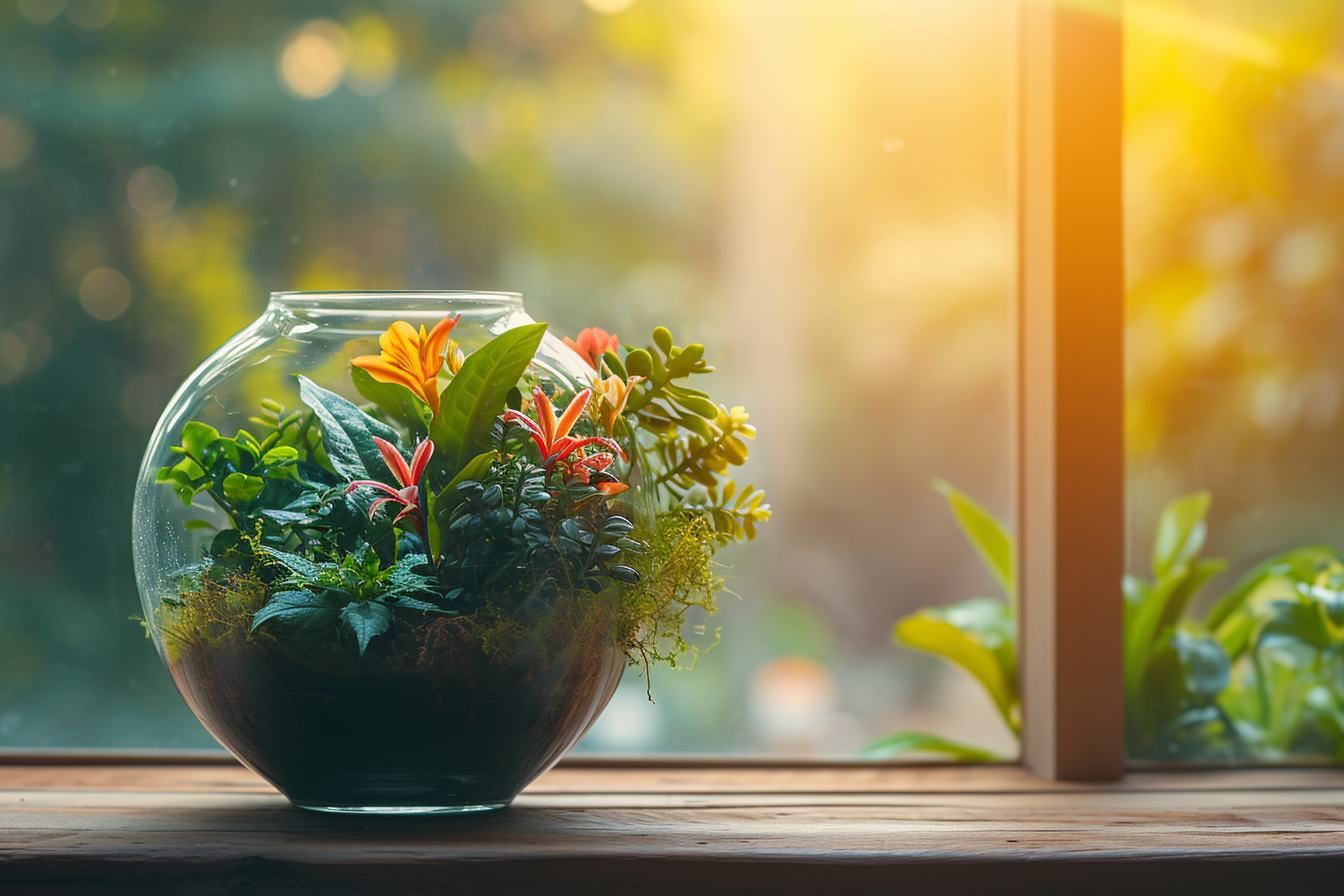
A tropical terrarium is a miniature ecosystem that simulates a tropical environment, enabling the cultivation of plants that thrive in warm, humid conditions. These glass-enclosed gardens provide an ideal setting for observing the intricate beauty of tropical flora within the confines of one’s home or office. Assembling a terrarium is an art, and maintaining it requires a fusion of gardening skill and environmental management.
Understanding the tropical environment
Humidity and Heat: Essentials of Tropical Habitats
Tropical plants are accustomed to the consistent warmth and high humidity of their native habitats. These two factors are central to replicating a tropical climate within a terrarium. Striking the right balance is critical for the thriving of these plants.
Lighting: Simulating the Tropical Canopy
In the tropics, sunlight filters through the densely layered canopy, providing dappled light to the forest floor. To mimic these conditions, terrariums need to be placed in an area where they receive bright, indirect light, or furnished with artificial lighting that caters to the specific needs of tropical plants.
Choosing the right vessel
Size and Shape: Room for Growth
The selection of the proper container is the first critical step in creating a tropical terrarium. A substantial container not only provides adequate space for plants to grow but also for the establishment of a self-sustaining microenvironment. Transparent containers are preferred for their ability to transmit light effectively.
Material Considerations: Glass vs. Acrylic
Glass is the traditional material for terrariums, offering clarity and resistance to scratching. Acrylic alternatives, while lighter and less fragile, can become opaque over time, potentially obstructing the view of your verdant miniature world.
Selecting plants for your terrarium
Consider Growth Habits and Space
When choosing plants for a tropical terrarium, contemplate their mature size and tendency to spread. Dwarf varieties and slow-growing plants reduce the need for frequent pruning and keep the terrarium from becoming overcrowded.
Diversity in Foliage and Color
A visually captivating terrarium includes a mix of plant species that offer a variety of textures, colors, and shapes. Ferns, bromeliads, and air plants with their diverse foliage can be complemented with colorful accents from flowering tropical plants such as orchids.
Planting your tropical terrarium
Layering the Foundation: Substrate and Drainage
Before introducing plants, a proper base must be established. At the bottom, a layer of gravel or activated charcoal ensures adequate drainage, preventing water from pooling and roots from rotting. Above this layer, a high-quality, well-draining soil mix promotes healthy plant growth.
Arrangement: Crafting a Miniature Landscape
In a terrarium, every plant plays a role in the composition. Taller plants offer height and structure, while ground covers fill in the lower levels, creating a lush understory. Attention to the natural growth patterns and needs of each species can help in creating a harmonious arrangement.
Achieving ideal humidity and temperature
Regulating Moisture: A Delicate Dance
Achieving high humidity is essential, but excessive moisture can lead to mold growth and rot. Thus, periodic ventilation may be necessary to maintain the proper humidity levels, along with regular misting.
Maintaining Temperature: Warmth is Key
Tropical plants commonly prefer temperatures between 65-85 degrees Fahrenheit (18-29 degrees Celsius). Positioning the terrarium away from cold drafts and providing supplemental heat during cooler months is often crucial for temperature-sensitive species.
Lighting for lushness and growth
Natural vs. Artificial Light
While natural light is often ideal, the amount and intensity of sunlight available might be insufficient, especially in non-tropical locales. In such cases, artificial grow lights present a viable alternative, capable of providing consistent and controllable illumination.
Timing: Duration Matters
Tropical plants generally require 12-14 hours of light per day. Utilizing a timer for grow lights can automate this process, ensuring a consistent photoperiod to regulate plant growth and maintain a seasonal rhythm.
Watering techniques for tropical terrariums
Methods of Irrigation: Misting and Drenching
Uniform misting simulates the fine rainfall of tropical climates and is an effective way to water terrarium plants while maintaining high humidity. Alternatively, less frequent but thorough drenching can provide deep watering, followed by a period of relative dryness to prevent root rot.
Observing Plant Responses
Plants are communicative, as their appearance often reflects their well-being. Drooping leaves may signal a need for more water, while yellowing leaves can indicate overwatering or poor drainage.
Fertilizing: key to nutrient equity
Selecting the Right Fertilizer
A balanced, water-soluble fertilizer suitable for tropical plants should be used sparingly to avoid the buildup of salts that can damage plant roots.
Periodic maintenance
Pruning: Encouraging Healthy Growth
Regular trimming of dead or overgrown foliage encourages new growth and maintains the aesthetic of the terrarium.
Cleaning: Clarity and Health
In order to prevent the growth of algae on the glass and maintain a clear view, regular cleaning is essential. Moreover, it ensures that maximum light reaches the plants.
Troubleshooting common issues
Combating Pests and Diseases
Vigilance is vital when it comes to detecting early signs of pests or disease. In such events, isolate affected plants and treat them promptly with appropriate remedies to avoid spread.
Managing Overgrowth
Strategic pruning and occasional replanting may be necessary to manage plants that outgrow their space or overshadow their neighbors.
The practice of cultivating tropical plants in terrariums is both a rewarding hobby and a creative outlet. A successful terrarium depends on the careful replication of tropical habitat conditions, the artful composition of diverse plant species, and the ongoing balancing act of managing light, water, and nutrients. With the right approach and dedicated attention, enthusiasts can witness the fascinating evolution of these enclosed jungles and enjoy the thriving beauty of tropical plants in their own living spaces.







Leave a Reply